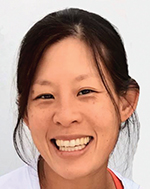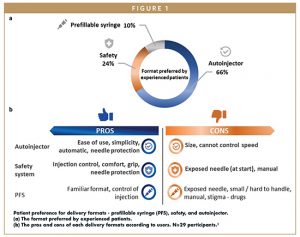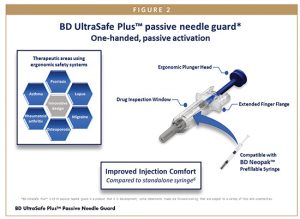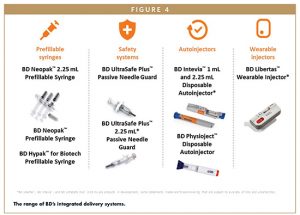Issue:September 2019
BIOLOGICS DELIVERY - Enabling Biologic Drug Delivery of Volumes Beyond 1 mL
ABSTRACT
Patients affected by chronic diseases commonly require regular injections of biologics, and many opt for self-injection. However, a wide range of biologics used to treat chronic diseases are now developed in volumes higher than 1 mL, requiring changes to the self-injection devices previously available. As the biological drug design space evolves toward formulations with larger dose volume and higher viscosity, the device industry is adapting by developing more innovative delivery systems. To accommodate these advances, delivery system manufacturers need to use methodologies and tools to manage conflicting requirements and to offer delivery solutions that balance performance, robustness, and usability while delivering higher volume or viscosity biologics. To support delivery of advanced biologics, BD offers safety systems, such as BD UltraSafeTM 2.25 mL passive needle guard, providing acceptable trade-offs to meet patient’s needs, such as easy-to-use, comfortable, and safe for its intended use
INTRODUCTION
The increasingly challenging therapies in development to treat chronic diseases are raising the bar for injection delivery technology performance to enable safe and effective pharmaceutical drug delivery. New usability issues associated with high-volume or high-viscosity formulations are requiring new technical innovations, such as large-volume autoinjectors, that enable performance beyond the traditional design space parameters (up to 2 mL and beyond).
High volume injections are becoming more challenging due to increased force required to inject the pharmaceutical drug within target injection time limits – limits that do not increase with larger dose volumes. Because of this, delivery systems that are safe, intuitive, easy to use, and appropriate for the target user population (which may have manual dexterity limitations) while capable of higher forces within the same injection time constraints are increasingly necessary.
Self-injections have traditionally been delivered in the form of autoinjectors, which reduce the force required by the user. By supplying extra force to the injection mechanism through internal design, autoinjectors have reduced the burden on patients to inject themselves with medication. However, not all therapeutic areas and patients are well suited to use autoinjectors. In some cases, patients prefer to manually control the injection rate.1 This may be due to perceived pain, a preference for greater control, or simply a desire to apply their medication with no external assistance.
From these trends, a question that arises is whether emerging biologic therapies that are formulated in the 1 to 2 mL dose delivery design space may also be delivered manually to address the needs of patients who prefer to retain manual control of injection. The following is a review of human factor data as well as packaging and drug delivery factors that should be considered when formulating drug therapies that are moving beyond the traditional subcutaneous dose volume delivered of 1 mL.
THE CHALLENGES OF BIOLOGICS FORMULATION & DELIVERY FOR CHRONIC DISEASES
In the field of chronic diseases, biologics are increasingly developed in high-dose formats, yielding high injection volumes (up to 2 mL and beyond) or viscosities (up to 30 cp and more). From the pharmaceutical manufacturer perspective, biologics are facing formulation challenges due to many conflicting requirements, particularly as they are now moving beyond 1-mL dose volume.
To achieve desired performance with a high-volume delivery system, acceptable trade-offs must be made between the following requirements:
-Large molecules, such as complex proteins should be formulated to increase target specificity.
-The drug should be sufficiently dosed to achieve the targeted efficacy.
-The liquid form should be stable enough to enable an easy process of self-injection at home by patients or caregivers, without drug reconstitution steps.
-Low viscosity range should be achieved to enable easy manufacturing (filling) and storage and to decrease the force required to deliver the solution.
-Injection time, force, ease of use, and handling comfort should support patient adherence to the therapeutic.
Biologics for subcutaneous injection may be highly concentrated, which can lead to high viscosity and can raise concerns of potential drug destabilization, due to aggregation of the molecules.2 Manageable viscosity can be achieved by lowering concentration; however, this can require a higher dose volume. Consequently, this could create difficulties for self-injecting patients due to increasing injection times and injection forces.
Drawing on this, some points should be considered in order to make high- volume delivery possible. First to consider is how to minimize the complexity of the injection technology? Another crucial point is the patients’ capability: will they accept a larger injection? Is it still possible for them to inject themselves manually or will the higher force and injection time negatively impact the patient’s adherence to treatment? Considering the packaging selection process, it is essential to select a primary container technology, such as the prefillable syringe, as soon as possible in biologic drug development while the final dosing and delivery format may not be fixed until the end of Phase 2. Yet the choice of patient delivery system may be inadvertently constrained by the choice of primary packaging. How can delivery system flexibility best be maintained during combination product development in order to facilitate patients’ ease of use while reducing risk to the drug development timeline?
Fortunately, the delivery system landscape is evolving to meet the needs of biotech companies, with multiple products in development to serve higher volume and higher viscosity biologics.
For instance, BD develops a variety of customizable patient self-injection systems, including autoinjectors, safety and shielding systems, and wearable injectors to serve current and emerging delivery needs. BD UltraSafe 2.25 mL passive needle guard is one example of a new solution that meets evolving pharmaceutical needs for biologics delivery.
DESIGNED FOR AN EASY SELF-ADMINISTRATION OF VOLUMES BEYOND 1 ML
Patient preference and sophistication concerning self-injection delivery systems is changing as well. BD’s qualitative research with self-injection experienced users showed that while more subjects used autoinjectors and prefillable syringes than safety systems at 62%, 31%, and 7% respectively, autoinjectors and safety systems were ranked No. 1 and No. 2 in terms of patient preference over stand-alone syringes the majority of the time (81%).1 Today, patient preference for delivery formats is evolving, and ergonomic safety solutions are becoming more prevalent for patients who prefer manual control of injection (Figure 1a).1 Figure 1b summarizes the pros and cons of the different delivery formats according to patients.1 Therapeutic areas that now utilize ergonomic safety systems for manual injections include rheumatoid arthritis, psoriasis, atopic dermatitis, asthma, and migraine among others.3
To support patients who prefer manual control of injection, BD has expanded its BD UltraSafe product range to work with prefillable syringes, such as BD NeopakTM 2.25 mL prefillable syringe (Figure 2).4 According to Tzvetelina Chevolleau, PhD, Clinical and Human Factor Program Leader, “as high-dose biologic formulations push current limits of self-injection into 1 to 2 mL formats and beyond, delivery systems that are intuitive and easy to use and targeted to specific user populations are becoming increasingly necessary.” While self-injection systems are often provided in the form of autoinjectors, manual injections, when given in an appropriate delivery format, can feasibly deliver injections that push the boundaries of volume or viscosity.5,6
With the BD UltraSafeTM 2.25 mL passive needle guard system, BD has addressed manual injections of volumes beyond 1 mL and conducted a human factors study to evaluate the usability, ease of use, and acceptance of this new system compared to injection with stand-alone prefilled syringes.7 This study on 63 subjects demonstrates that on average, more than 70% of subjects consider this delivery system easy or very easy and acceptable or very acceptable to hold during injection and to push the plunger.6 Overall, users were able to properly manipulate it regardless of the “instructions for use” availability (with or without instructions), attesting to the ease of use of this product.6 According to the findings, BD UltraSafe 2.25 mL (Plus* and Passive systems) was preferred over a stand-alone syringe for ease of use and injection comfort.6 Most participants consider the time required to use this product acceptable. With this study on the BD UltraSafe 2.25 mL passive needle guard, BD provides evidence that it is easy to use, comfortable to hold and inject, and safe for its intended use (Figure 3).6

Click image to enlarge
SYSTEM INTEGRATION OF COMBINATION PRODUCTS
Today, self-injection systems allow patients to receive their drugs ready-to-use, such as in prefilled injection devices. Prefilled systems limit manipulation of the drug by the patient and therefore reduce the risk of error during the self-injection process compared to a vial and syringe.8
Drug-device combinations include autoinjectors, wearable injectors, safety systems, and prefilled syringes. To launch these complex systems, pharmaceutical companies must separately select, develop, and assemble multiple components to optimally work together in order to deliver a safe and effective drug formulation. However, during combination product development with higher dose biologics, system conflicts may arise and may incur high costs. The typical sequence (selecting primary packaging during Phase 2, then developing the delivery system later when dosing is fixed or the preferred delivery presentation identified) may result in a need to modify the delivery system or possibly the primary container in case of incompatibility. In this case, a high cost based on resources and lost time may be incurred. The primary container with its intrinsic performance and integration attributes can critically affect delivery system performance, and this is why having a strategic partnership with delivery system and primary container manufacturer(s) is essential.
Lionel Maritan, Research & Development Associate Director, states that “BD is committed to optimizing system integration of combination products to avoid problems related to poorly integrated systems, such as breakage, incompatibility, and non-performance encountered when different components are purchased from a variety of suppliers. This quality-by-design approach deployed at every interface between the drug, container, and delivery device can significantly reduce the risk of potential delay to launch timelines and financial loss.”
INTEGRATED SYSTEM DEVELOPMENT: BD’S COMMITMENTS
To address these challenges and improve combination product system performance, BD dedicates deep R&D expertise and experience to design delivery systems. As one of the world’s leading suppliers which offers both primary containers and secondary delivery systems, BD provides the assurance of a broad array of expertise throughout the product development process, by working closely across technology platforms to define system interfaces from the early design phases through manufacturing strategy and execution. To benefit pharmaceutical companies, BD offers a solution that balances performance, robustness, and usability to meet the needs of biotechnology companies that are developing drug products which are increasingly challenged with a larger dosing volume and/or a higher viscosity.
Due to the complex combination product selection process described earlier, BD integrates the BD Neopak prefillable syringe technology for biologics into their self-injection systems, providing multi-platform flexibility to utilize innovative delivery solutions across a range of dose volumes and viscosities (Figure 4). With integrated solutions, such as BD LibertasTM wearable injectors, BD InteviaTM disposable autoinjectors, and BD UltraSafe needle guards, pharmaceutical companies can take advantage of greater choice and flexibility to serve diverse patient groups, therapeutic areas, and markets with the appropriate delivery format. Finally, as BD Neopak may be used in combination with a broad range of secondary delivery systems, the costs associated with managing multiple component interfaces and suppliers can be minimized.
BD Neopak was specifically designed to address aggregation issues with sensitive biologics by minimizing drug/container interactions.6,7,9,10 In addition to conventional benefits of prefillable syringes (PFS), BD Neopak supports autoinjector performance with higher volume or viscosity biologics through tightly controlled gliding and dimensional precision, tightened specifications, and low part-to-part variability.3,5 Supporting PFS performance within an autoinjector can allow pharmaceutical companies to contain costs and minimize risks.11 Additionally, the BD Neopak portfolio of options covers a broad design space for enabling agile development and facilitating time to market. This platform is built on decades of BD’s experience partnering with leading biopharmaceutical companies to support drug development and launch. BD Neopak was conceived with a solution-finding mindset, allowing pharma and biotech companies to tangibly meet current and future needs for biotech drugs.
SUMMARY
To address biologic development issues, BD is applying its knowledge base gained from a long history with combination products. With its portfolio of integrated systems, BD offers continuous process and service improvements to increase pharmaceutical companies’ flexibility to meet patients’ needs with the right delivery solutions. BD’s integrated systems are intended to mitigate system performance risks, optimize cost savings, and prevent combination product launch delays. Considering the evolving biologic drug design space and shifting patient preferences, BD has developed high-volume, ergonomic safety solutions. BD has demonstrated through a human factors study that BD UltraSafe 2.25 mL passive needle guard is easy to use, preferred, and safe for its intended use. Manual systems, when provided in a suitable delivery format, can feasibly deliver injections that push the traditional boundaries of volume.
* BD UltraSafe Plus™ 2.25 mL passive needle guard is a product that is in development; some statements made are forward-looking that are subject to a variety of risks and uncertainties.
REFERENCES
- Autoinjector patient preference market research [Qualitative research]. USA and UK; 2016.
- Mathaes, Roman, et al. “Subcutaneous injection volume of biopharmaceuticals—pushing the boundaries.” Journal of pharmaceutical sciences 105.8 (2016): 2255-2259.
- Therapeutic areas and drug type using BD safety devices [Internal analysis]. Pont de CLaix, FR, Becton Dickinson and Company; 2016.
- Compatibility study of BD Safety UltraSafe PlusTM with BD 1ml long glass syringes [internal study]. Pont-de-Claix, FR: Becton, Dickinson and Company; 2014.
- Simulated usability study of BD UltraSafeTM and BD UltraSafe PlusTM passive needle guard [internal study]. Pont-de-Claix, FR: Becton, Dickinson and Company; 2012.
- Silicone quality and Silicone profile [Internal Study]. Pont-de-Claix, FR: Becton Dickinson and Company; 2013.
- A Simulated Study of BD UltraSafeTM Needle Guard 2.25 ml devices [Internal study]. Pont de Claix, FR: Becton Dickinson and Company;2014.
- Global Value Dossier Vial to prefill product portfolio [Internal study]. Franklin Lakes, NJ USA: Becton Dickinson and Company; 2017.
- BD NeopakTM Process verification [Internal Study]. Pont-de-Claix, FR: Becton Dickinson and Company; 2014.
- BD NeopakTM 1 mlL Long Term Verification: Glue Extractables [Internal Study]. Pont-de-Claix, FR: Becton Dickinson and Company;2014.
- Boehringer Ingelheim – Friedrich Haefele., Translating a Quality by Design PFS Into Tangible Value for Biopharmaceuticals. PDA Universe of Pre-filled Syringes and Injection Devices October 6-8, 2014.

Megan Lan leads Global Marketing for the safety portfolio at BD Medical-Pharmaceutical Systems. She provides commercial leadership to BD’s delivery system platforms and defines, develops, and launches patient-centered self-injection and safety systems in collaboration with cross-functional, commercial, and regional teams. She has also developed pen injectors and autoinjectors and participated on ISO committees to improve standards influencing patient safety and usability. She previously served in public health and development with the Peace Corps in Central America and worked in product development at Kimberly-Clark Corporation. She earned her MBA and MA at the University of Pennsylvania and has an undergraduate degree in Biomedical Engineering.

Patrick Le Gal has been with BD Medical-Pharmaceutical Systems since 2006 in different roles in New Product Development and Innovation Management, working with pharmaceutical companies to develop and bring to market drug delivery solutions from prefilled syringes to complex injection systems. He is a Mechanical Engineer by training (1993) and started his career in the automotive industry in various R&D positions, where he has focused on system integration, and also on elastomeric systems development and manufacturing. He is currently R&D Director for advanced drug delivery solutions at BD, such as safety systems, autoinjectors, pens, and wearable injectors, where his responsibilities include innovation, new product development, and sustaining activities.
Total Page Views: 6453













